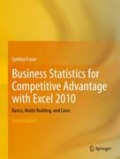
Business statistics for competitive advantage with Excel 2010: basics, model building, and cases
Fraser, Cynthia
Exceptional managers know that they can create competitive advantages by basing decisions on performance response under alternative scenarios. To create these advantages, managers need to understand how to use statistics to provide information on performance response under alternative scenarios. This updated edition of the popular text helps business students develop competitive advantages for use in their future careers as decision makers. Students learn to build models using logic and experience, produce statistics using Excel 2010 withshortcuts, and translate results into implications for decision makers. The author emphasizes communicating results effectively in plain English and with compelling graphics in the form of memos and PowerPoints. Statistics, from basics to sophisticated models, are illustrated with examples using real data suchas students will encounter in their roles as managers. A number of examples focus on business in emerging global markets with particular emphasis on China and India. Results are linked to implications for decision making with sensitivity analyses to illustrate how alternate scenarios can be compared. Chapters include screenshots to make it easy to conduct analyses in Excel 2010 with time-saving shortcuts expected in the business world. PivotTables and PivotCharts, used frequently in businesses, are introduced from the start. Monte Carlo simulation is introduced early, as a tool to illustrate the range of possible outcomes from decision makers’ assumptions and underlying uncertainties. Model building with regression is presented as a process, adding levels of sophistication, with chapters on multicollinearity and remedies, forecasting and model validation, autocorrelation and remedies, indicator variables to represent segment differences, and seasonality, structural shifts or shocks in time series models. Special applications in market segmentation and portfolio analysis are offered, and an introduction to conjoint analysis is included. Nonlinear models are motivated with arguments of diminishing or increasing marginal response,and a chapter on logit regression models introduces models of market share orproportions. The Second Edition includes more explanation of hypothesis testsand confidence intervals, how t, F, and chi square distributions behave. Focuses on statistical model building and Analysis not Theory. Covers the full gamut of Excel properties and utilities for Business Stats, including allshortcuts. All communicate very clearly with concise tables and screen shots.Statistical Analyses are translated into concise Business English Applications. Applications are taken from actual Business problems. INDICE: Statistics for Decision Making and Competitive Advantage. Describing Your Data. Hypothesis Tests, Confidence Intervals and Simulation to Infer Population Characteristics and Differences. Quantifying the Influence of Performance Drivers and Forecasting: Regression. Marketing Sgementation with Descriptive Statistics, Inference, Hypothesis Tests and Regression. Finance Application: Portfolio Analysis with a Market Index as a Leading Indicator in Simple Linear Regression. Association between Two Categorical Variables: Contingency Analysis with Chi Square. Building Multiple Regression Models. Model Building and Forecasting with Multicollinear Time Series. Indicator Variables. Nonlinear Multiple Regression Models. Indicator Interactions for Segment Differences orChanges in Response. Logit Regression for Bounded Responses.
- ISBN: 978-1-4419-9856-9
- Editorial: Springer New York
- Encuadernacion: Rústica
- Páginas: 338
- Fecha Publicación: 08/12/2011
- Nº Volúmenes: 1
- Idioma: Inglés
